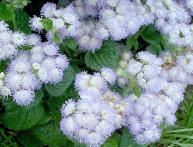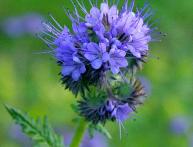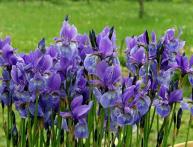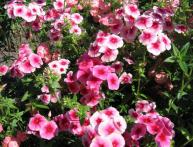How to plant Dieffenbachia: preparation, cultivation and care
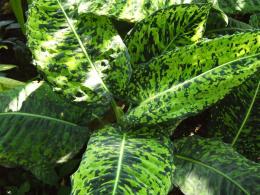
Decorative foliage plant Dieffenbachia with its external exotic appearance it has found its application in interior landscaping. Large variegated leaves and an extraordinary height reaching 2 meters show worthy characteristics of a multi-species representative of the tropical flora of America. The evergreen culture of the aroid family belongs to unpretentious plants with certain rules for planting and growing.
Content:
Preparing for landing
Dieffenbachia can be planted at any time of the year. The most optimal time for planting is from spring to autumn. The soil for the plant should have a light, loose, water- and breathable structure. Heavy substrates are not suitable for Dieffenbachia. The best option is considered to be a slightly acidic substrate, which includes in portions:
- leaf soil (2)
- chopped sphagnum (1)
- sand (0.5)
- coniferous land (1)
- crushed charcoal (0.5)
When choosing soil, it is necessary to take into account the absence of peat in its composition, which causes fungal diseases due to moisture retention. The planting container for Dieffenbachia should be a spacious pot for further growth.
Particular preference is given to an environmentally friendly natural clay pot, through the porous material of the vessel walls, excess moisture evaporates.At the same time, plant roots gain access to oxygen. The massiveness of the clay material container is stable and suitable for growing a large plant. The presence of drainage holes also allows you to maintain the necessary humidity. A clay pot maintains a temperature balance for Dieffenbachia: warm in winter, cool in summer. Preparing for landing flower is an important factor on which the correct choice of soil and container depends.
Planting a plant
Direct planting of a plant consists of choosing a high-quality sprout and fulfilling the requirements of the planting sequence. When choosing a sprout, its external condition is taken into account. Preference is given to medium-sized plants. Careful inspection excludes sprouts:
- with withered, dried out and yellow leaves
- with soft stems
- with broken and dry roots
- with no signs of disease or pests
Step by step planting:
- A layer of expanded clay drainage is laid on the bottom of the pot.
- The prepared substrate is poured, not reaching the edge of the pot by 5-7 cm.
- A depression is made in the middle of the pot.
- The sprout is placed and the roots are carefully straightened.
- Sprinkle with soil and lightly compact.
- Water moderately.
- Planting a seedling too deep can lead to its death.
Correct landing flower in compliance with a certain sequence is the first prerequisite for rapid development.
Cultivation and care activities
The unpretentiousness of the plant nevertheless requires good care. Creating the necessary conditions contributes to the full development and rapid growth of Dieffenbachia. The adaptation period immediately after planting consists of placing the seedling in a warm place.
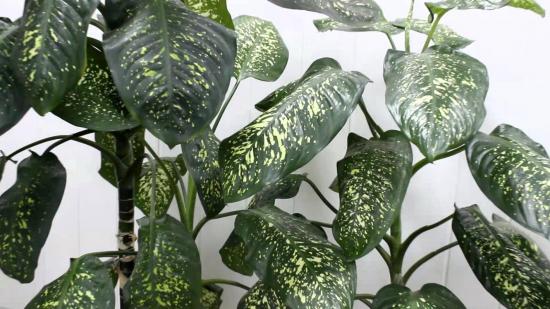
In the first days, watering the plant is limited.For better root survival, the top layer of soil is loosened. If good lighting is insufficient, artificial lighting is added. A mandatory requirement during the period of adaptation of a flower to a new place is the absence of a draft.
Watering and humidity
Water treatments for the plant are especially important. A mandatory requirement for water is the absence of lime. Suitable water for irrigation: filtered, boiled, settled or rainwater. In summer and spring, water every 3 days, with intermediate spraying and wiping the leaves between waterings.
In winter, the number of procedures is reduced and carried out only when the soil is dry. At low room temperatures, watering is replaced by spraying. Alternation recommended glaze: under the root and into the pan. The optimal humidity for a flower should be in the range of 35-45%.
Top dressing
A powerful plant spends a lot of energy every day to grow. Good regular feeding correctly shapes the development of Dieffenbachia. Fertilizers are applied every 10 days from spring to autumn. During the rest of the period, fertilizing is not needed, since in the cold season, due to the suspension of growth, the plant does not require fertilizer.
Fertilize by alternating liquid mineral and organic fertilizers. Lack of feeding has a negative impact on the lower leaves and their falling off. When applying fertilizer with nitrogen for Dieffenbachia species with white leaves, it is necessary to ensure that the amount is exceeded. The plant may turn green and lose its decorative properties.
Temperature
A comfortable, warm atmosphere should accompany the culture all year round. The temperature should be maintained at 20-22 degrees.The exception is winter, where the temperature can drop by 2-3 degrees. During the windless summer period, the plant should be taken outside or onto a balcony. This contributes to its harmonious development. The rest of the time, Dieffenbachia is protected from drafts.
Lighting and location
Lack of lighting has a bad effect on the external condition of the plant and leads to wilting. Direct scorching rays of the sun can cause burns to the leaves. To avoid the negative effects of the sun, the place for the flower must be determined on the east or west side.
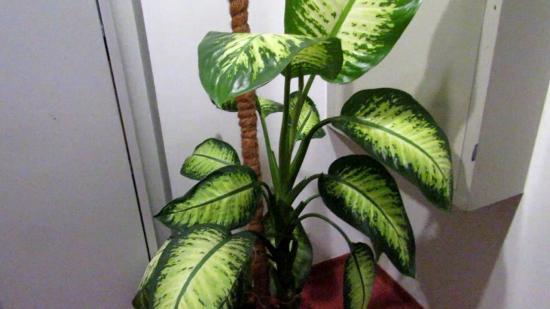
Insufficient lighting is indicated by the plant trunk tilting to the side. In the absence of insufficient light, especially in winter, it is necessary to use special phytolamps. Ideal lighting for the plant is diffused light.
Dieffenbachia pruning
Under favorable development conditions, the flower produces a new leaf every week. Pruning is carried out at any time of the year using a sharp knife pre-treated with alcohol. The juice that comes out during circumcision should be blotted with a well-absorbing cloth or napkin. Treat the cut areas with crushed coal.
Features of pruning are as follows:
- For stem species, after 3 years the stem is cut to a stump up to 10 cm in height
- For bush species, dried, broken and damaged leaves are removed
- the top of a plant that is too tall is cut off by a few centimeters
Being a poisonous plant, Dieffenbachia contains toxic sap, so pruning should be done with gloves. After trimming the trunk, the flower is not watered for several days to reduce the secretion of poisonous juice. The stump is covered with a transparent bag and tied.The bag is periodically removed to ventilate the cut area.
Activities for growing the plant are mandatory and must be carried out strictly and impeccably, despite the fact that Dieffenbachia is an unpretentious flower. Particular attention is paid to the adaptation period after landing, on which further development depends.
A tropical plant grown in our climate requires not only the correct sequential actions during preparation and planting, but also the implementation of advice and recommendations for care.
Video about flower transplantation:





